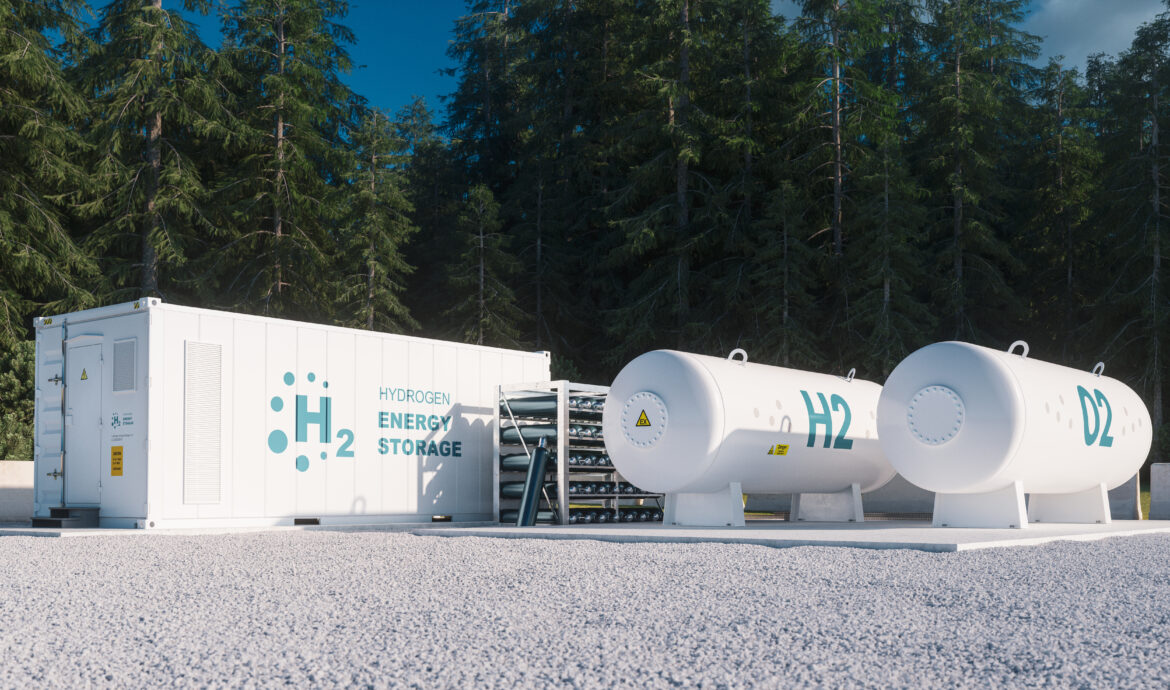
Is there a role for blue hydrogen in a green energy transition?
On 23.09.2022 by Russell McKenna, Anna Peecock, Alfonso Martinez-FelipeBy Russell McKenna, Anna Peecock, Alfonso Martinez-Felipe

Russell McKenna is Full Professor of Energy Systems Analysis at ETH Zurich and Head of the Laboratory for Energy Systems Analysis at the Paul Scherrer Institute. He is also an Honorary Professor of Energy Transition in the School of Engineering and Centre for Energy Transition at the University of Aberdeen. He is an aerospace engineer with a background in energy system modelling and energy economics.
Anna Peecock is a PhD student at the University of Aberdeen, using energy system modelling to research potential synergies between offshore wind and Oil & Gas in the North Sea, in order to reduce production emissions and abandonment costs, as part of a low-carbon energy transition.
Dr Alf Martinez-Felipe is senior lecturer in chemical engineering, and co-champion of the hydrogen theme at the Centre for Energy Transition of the University of Aberdeen. His research focusses on proton exchange membrane fuel cells, polymeric electrolytes, liquid crystals, solid oxide fuel cells, hydrogen economies and energy conversion and storage.
The global energy transition requires a dramatic shift towards renewable and low-carbon energy technologies. Hydrogen is one of these and can be used to store intermittent solar and wind power. As well as being produced from green electricity by electrolysis, it can also be manufactured by capturing and storing carbon dioxide during the conversion of natural gas. This blog article sheds light on the role that these two options of low-carbon hydrogen production could play in the near and far future.
With its potential as an energy carrier that supports an increasingly renewable electricity grid, hydrogen can complement and accelerate other technologies required to deliver net-zero CO2 emissions by 2050. Incorporated into the decarbonisation strategies of many large economies, hydrogen is gathering momentum as a key pillar of the global green energy transition and has the potential to play an important role in ensuring decarbonisation targets are met. Hydrogen is a stable chemical energy storage with a wide variety of uses across the energy system. It is true – as many critics point out – that some applications such as hydrogen-fueled space heating and passenger cars are inefficient, expensive and for these reasons do not currently (or will never) make environmental or economic sense. Other applications and sectors, especially those referred to as hard to decarbonise or electrify, such as some industrial processes, base chemicals and the production of sustainable aviation fuels will all need to rely on hydrogen to some extent. In other words: there are more and less useful applications for hydrogen and these can be classified on the basis of the so-called hydrogen ladder.
Blue and green hydrogen
Today, hydrogen production is almost entirely based on fossil resources and causes substantial greenhouse gas emissions. However, there are two methods currently widely considered for large-scale generation of decarbonised hydrogen. Green hydrogen is produced by water electrolysis driven by renewable electricity. Blue hydrogen is derived from reforming natural gas at high temperature and pressure in combination with carbon capture, storage (CCS) technologies. For reference, just over 100 Mt of hydrogen are produced annually, 1% of which is blue and 0.1% is green – the remainder is mainly grey and other colours that will not be discussed here. However, there is a fierce dichotomy of opinions on the role of blue and green hydrogen in a decarbonised economy. Whilst blue hydrogen is often maligned as a distraction from decarbonisation efforts, disincentivising corporate investment in clean technologies by perpetuating the use of fossil resources, others consider it a crucial interim measure to facilitate a future hydrogen economy.
Even though we acknowledge that our ultimate goal should be producing green hydrogen from renewable-powered electrolysis, green hydrogen is currently still scarce and prohibitively expensive. This arises not solely from the cost of renewable electricity, which is rapidly becoming cost-competitive with other energy sources, but rather from the current cost of electrolysers themselves. Nevertheless, costs of green hydrogen are expected to drop substantially from above 3 USD/kg today and reach levels of around 2.5 USD/kg in 2030 and less than 1 USD/kg in 2040.
Why blue hydrogen should not be dismissed
Still, scarcity of green hydrogen is likely to remain an obstacle, as the rate of deployment of renewable technologies is constrained by investment, planning and infrastructure developments. In addition, low-carbon may firstly be used to electrify sectors like transport and space heating. For these reasons, blue hydrogen should not be dismissed.
In the short-term, lower generation costs and opportunities to repurpose existing infrastructure could stimulate a rapid scale-up in trade of blue hydrogen. If compatible with a sustainable energy system (i.e. if specific criteria are met, see below), this presents an opportunity to establish a hydrogen economy that can then begin a phased transition from low to zero-carbon generation. A co-benefit of scaling up blue hydrogen production, transportation and storage in the shorter-term would be the priming of the energy system infrastructure, ready for the subsequent integration of mainly green hydrogen. As well as upgrading and repurposing existing (natural) gas infrastructure, this would include important Carbon Capture and Storage (CCS) systems, which will be an indispensable part of net-zero future energy systems.
There are, however, concerns regarding the sustainability of blue hydrogen. Some researchers have condemned blue hydrogen as wholly incompatible with a decarbonised energy future. They identify fugitive methane emissions in the natural gas supply chain and CO2 emissions from the hydrogen plant as fundamental and irremediable. Claiming to present a “best-case” scenario, they go on to suggest the greenhouse gas footprint of blue hydrogen is more than 20% greater than burning natural gas and imply that promotion of blue hydrogen is solely being driven by the self-interest of the Oil & Gas industry. Recently another group of researchers (including the first author of this blog) challenged those conclusions, which are based on data from a first-of-its-kind steam methane reforming plant with CO2 capture, designed to demonstrate technical feasibility rather than optimised efficiency. The responding authors maintain that the initial claim of blue hydrogen being incompatible with decarbonisation lacks scientific rigour, presents an unrealistic picture, and is potentially misleading. The responding authors instead demonstrate that the climate impacts associated with blue hydrogen can be mitigated by ensuring low methane emissions and high CO2 capture rates. The additional research of a further group of scientists (again, the first author of this blog included) also supports this conclusion, and presents blue hydrogen as an attractive bridging technology with similar climate change impacts to green hydrogen, compatible with low-carbon economies. Another concern raised against blue hydrogen is the continued reliance on fossil fuels, which exposes price and supply to market volatility, thereby failing to support the goal of increased energy security. At the time of writing, an energy crisis has pushed up natural gas prices to their highest levels in over ten years, which is creating huge uncertainty about investments in and supply from this fuel. However, as a short-term solution, the benefits of driving investment in and deployment of CCUS technologies arguably outweighs the temporary delay in fossil fuel renunciation. Furthermore, the current rate of development of renewable alternatives to fossil fuels, which still account for around 85% of global primary energy demand, means the continued reliance on some fossil fuels for future decades is inevitable.
Blue hydrogen in a decarbonised energy future
As with any emerging technology, the need for target-oriented policy is particularly important in the case of blue hydrogen. Meaningful thresholds for methane emissions from natural gas supply chains and carbon capture rates at hydrogen production facilities are crucial for ensuring blue hydrogen makes a positive contribution to decarbonisation – indeed to define the criteria that should confer the label of blue hydrogen. If these can be met, blue hydrogen has a pivotal role to play in scaling-up hydrogen volumes in the short-term and driving commercial development of associated infrastructure and technologies along the value chain. Until commercial-scale green hydrogen production is successfully deployed and becomes cost-competitive, blue hydrogen offers an attractive bridging technology that, under rigorous environmental regulation, can have a positive environmental impact and support the transition to a decarbonised energy system. The levelized cost of blue hydrogen were around 2-3 times lower than green hydrogen in 2020, but the currently high natural gas prices tip the balance strongly, meaning the economic case for blue hydrogen is between weak and non-existent. Assuming that natural gas markets relax in the medium term and prices return to more modest levels, policymakers need to develop regulations to clearly define the criteria blue hydrogen must fulfill in order to be environmentally sustainable. This will necessitate some sort of certification scheme to at least account for the upstream fugitive methane emissions and the level of carbon capture on the system. Similar policies already exist for other energy technologies such as boilers and vehicles, so this is by no means unchartered territory.
Cover photo by Adobe Stock Images
Keep up with the Energy Blog @ ETH Zurich on Twitter @eth_energy_blog.
Suggested citation: Peecock, Anna; McKenna, Russell and Martinez-Felipe Alfonso. “Is there a role for blue hydrogen in a green energy transition?”, Energy Blog @ ETH Zurich, ETH Zurich, September 23, 2022, https://blogt.ethz.ch/energy/blue-hydrogen-green-transition/
If you are part of ETH Zurich, we invite you to contribute with your findings and your opinions to make this space a dynamic and relevant outlet for energy insights and debates. Find out how you can contribute and contact the editorial team here to pitch an article idea!
